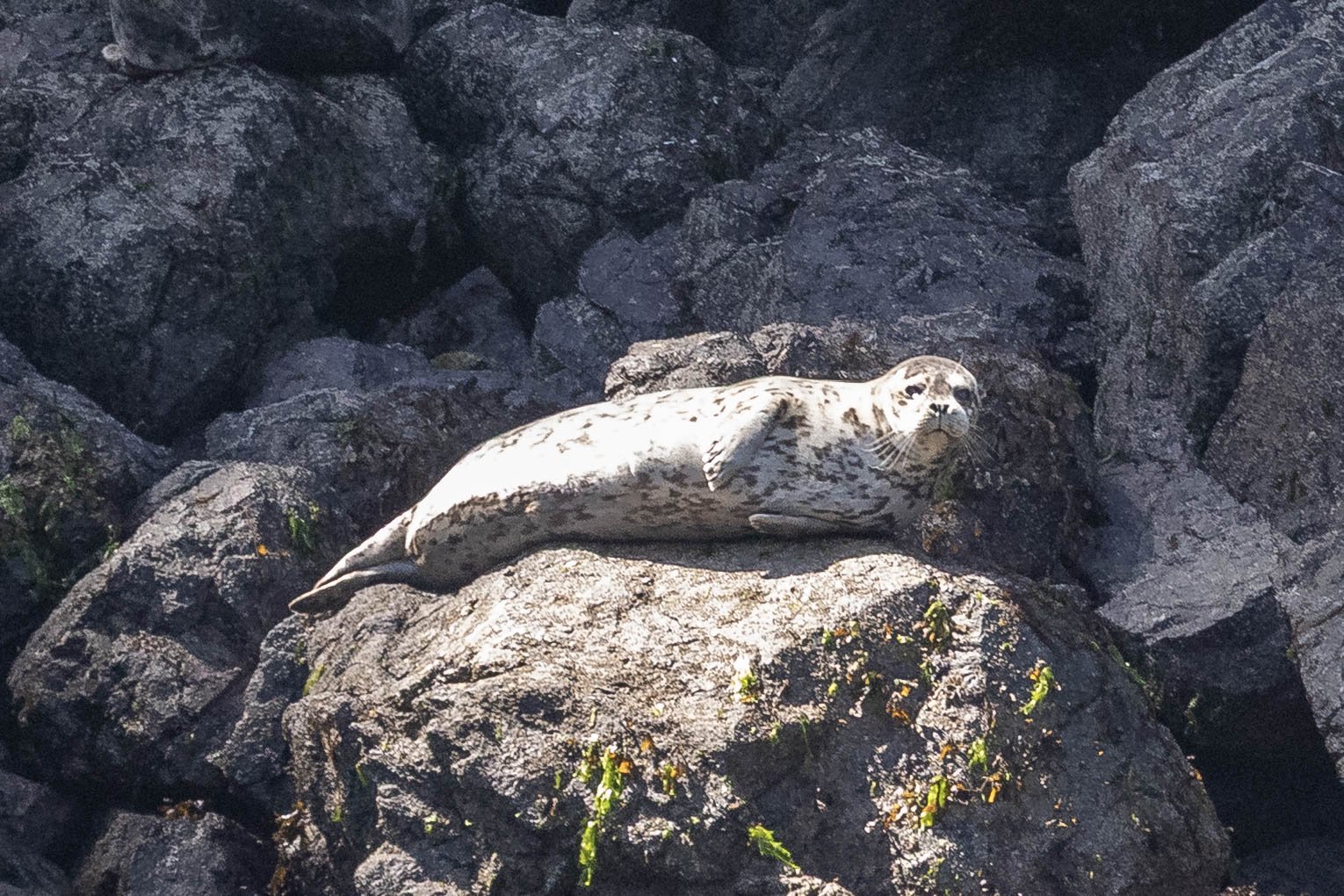May 1, 2025, 11:00 AM - Charter with Pacific White Sided Dolphins!
Today we departed a bit earlier than we normally do, heading out with our Charter to see what we could find! We had a report of a possible sighting in Horseshoe Bay, so we decided to try our luck. We started out across the Strait, making our way to the beautiful Howe Sound.
We spend a good amount of time exploring the Sound, keeping our eyes peeled for whales. This area is often a favourite spot for guests, as they take in the picturesque views and stunning turquoise waters. Howe Sound is one of Canada’s nineteen UNESCO Biosphere Reserves, a region dedicated to upholding sustainable development, protecting biodiversity, and education and research in these fields. This is a global mission, with 759 regions all over the world!
Zigzagging through the islands of the Sound, we soon found something of interest: Pacific White Sided Dolphins! These small cetaceans, commonly referred to as ‘Lags’, in reference to their genus classification Lagenorhynchus, were spotted cruising along the coastline.
Seeing the white sided dolphins is such a treat! For many years, these playful cetaceans were primarily seen much further north, making them a rare sight on our tours. However, in recent years, we have seen them making their way further south, especially along the coastline of the Sunshine Coast. While we were treated to only a few animals on this tour, these dolphins commonly associate in pods that can be 100 animals strong. In offshore encounters, there have been cases of multiple pods travelling together in superpods, consisting of thousands of animals! Pacific white sided dolphins are a technically a pelagic species, meaning they are most commonly found in open waters, and unlikely to be found along coastlines. Someone should tell these dolphins that! They have a very extensive range, and can be seen along the American west coast, throughout the Pacific Northwest, and up through Alaska. Current estimates put their population at around 25,000 animals along the coasts of BC.
These cooperative animals work together to herd their prey, consisting of small schooling fish, such as Herring. Each adult needs about 20 pounds of food per day. Luckily, food is abundant for these little guys. However, they haven’t always had it so easy. In the late 1980s and early 90s, large numbers of Pacific white sided dolphins were victims of bycatch. Large-scale industrial drift nets used by Japanese fisheries accidentally captured, injured and killed thousands of these dolphins before they were banned by the United Nations in 1993. After these fisheries shut down, no other large-scale fisheries in the North Pacific have employed these methods. However, these animals are still susceptible to entanglement from other netting and fishing equipment, just like many of the other species present in the Salish Sea, such as Humpback Whales.
Another primary threat to these small dolphins is the abundance of their natural predators, the Orca. While known to peacefully coexist (and even travel with) our fish-eating Southern Resident Killer Whales, the Biggs orca won’t hesitate to make quick meals out of these tiny cetaceans. But why spend time with Orca at all? Curiosity? One line of thinking believes that they may be analyzing killer whale behaviour to better familiarize themselves with them, so as to better avoid the predatory Biggs. I guess we’ll never know for sure!
After spending some time with the lags, we continued on our way to see what else we could spot. As we made our way towards Nanaimo, we made a stop at a great wildlife hub, Entrance Island. Built in the late 1800s to bring the ships into Nanaimo’s harbour, Entrance Island is one of the few remaining manned lighthouses here in Canada. Aside from its iconic red roofs, Entrance is a wonderful spot to see the Sea Lion haulouts. We got to see both Stellar and California sea lions at this spot, two iconic pinnipeds here in the Salish Sea. Next, we went over to the next rocky outcrop to see another well-loved pinniped: the Harbour Seal! After spending time with these robust cuties, we finished up the tour checking out the Gabriola coastline, which is a fantastic spot to check out both the nesting Cormorants and Bald Eagles.
While we had no luck with whales on this tour, we still got to see some fantastic wildlife. All photos taken by naturalist Hayleigh Hilbert.
A few Pacific White Sided Dolphins.
These dolphins get their name for their unique, and highly identifiable markings.
A Harbour Sea lounges in the sun.
King of the rock!
Look at the fantastic camouflage on these guys!
A Steller Sea Lion cuddle puddle.
Check out the size difference between males and females.
Stampede!
Look at the size of those teeth on this California Sea Lion.
Steller’s on high alert.
Pupping season is just around the corner.
Cormorants soak up the rays.
Nesting season well underway!
A Bald Eagle watches carefully.
Entrance Island.


















